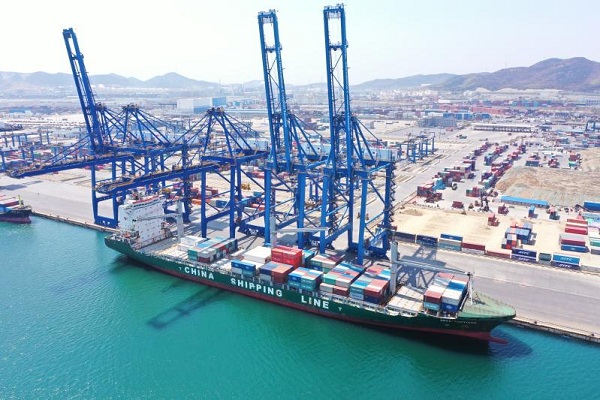RCEP will spur development across China, region and world

A ship unloaded 565 tons of dragon fruit imported from Vietnam at the Dalian container terminal in Dalian, Liaoning province, on April 27, 2020. [Photo by Yu Xinwen/for chinadaily.com.cn]
In terms of investment, all 15 member countries have adopted negative lists for foreign investment to make open commitments to investment in the non-services sector, increasing policy transparency.
In terms of rules, the RCEP comprehensively benchmarks international high-level free trade rules in e-commerce, intellectual property rights, government procurement, small and medium-sized enterprises and other areas, providing long-term institutional protection for optimizing the business environment in the region.
Second, the RCEP has changed the status quo of the fragmentation of FTAs in the region, forming for the first time a unified system of trade and investment rules in the region. Previously, the 10 ASEAN countries and five other countries signed FTAs, rules of origin, open rules of investment and trade rules in services. After the formation of the unified rules of the RCEP, companies will continue to see the dropping operational costs and uncertainty risk. This will effectively stimulate business vitality in the region's business activities.
Since all RCEP member countries have adopted a negative list for foreign investment to boost the investment in the non-services sector, economic policies will be more transparent, and cross-border investment and e-commerce will gain huge growth space across the region.
Because the RCEP brings together six of the world's 20 most populous countries, the huge consumer market has great potential, and the high-level opening-up of regional standards will support the transfer of consumer markets from developed to developing member countries. It will stimulate more demand for various products and provide sufficient sustainable impetus for companies' growth throughout the region.
Third, the RCEP deal creates a new situation in the open world economy. Since protectionism and unilateralism have caused uncertainty and instability, the world economy has shrunk, and so have international trade and investment.
Thanks to the encouraging results achieved by the signing of the RCEP, companies are the beneficiaries of this pragmatic cooperation. It certainly will impart momentum to China's economic development and foreign cooperation, if the government, companies, trade and investment promotion agencies are able to achieve effective linkages and make full use of the preferential provisions of the RCEP.
Under the terms of the RCEP agreement, regarding the adjustments to the relevant domestic laws, regulations and management measures, the governments concerned should further relax market access restrictions, in order to create a fair and high-level business environment.
They should also provide a greater platform and create more favorable conditions for companies to further expand the East Asian market. Besides, they should build more stable regional industrial and supply chains.
Through a variety of channels to let the world better understand the RCEP policies, China will promote the ongoing talks of the China-Japan-Republic of Korea FTA, actively press ahead with regional economic integration for the early realization of a free trade area of the Asia-Pacific, and promote institutional opening-up in terms of rules, regulations and management standards.
Under such circumstances, companies should actively study RCEP rules and operating mechanisms, re-examine the RCEP, which represents a large market with unified rules composed of "10+5" member states, and participate in international cooperation and competition.
Based on their own needs, companies can make more effective use of preferential trade and investment arrangements in the region, carry out corporate strategic investment planning, reconstruct the supply and value chains in the region, optimize production layout and upgrade the industrial structure.
It is also necessary to pay attention to the management of rules on the country of origin, and actively use preferential origin documents for export, in accordance with the rules on the origin of the FTA.
Companies must make better use of both domestic and international markets as two vital resources. They should increase import and export trade, and expand foreign investment, from raw materials to labor, from capital to technology, from production to market. This way, they can optimize the allocation of regional resources for improvements in quality and efficiency, and for industrial upgrading, so as to open up a broader space for future growth.
The writer is chairwoman of the Beijing-headquartered China Council for the Promotion of International Trade, and former vice-minister of commerce.


